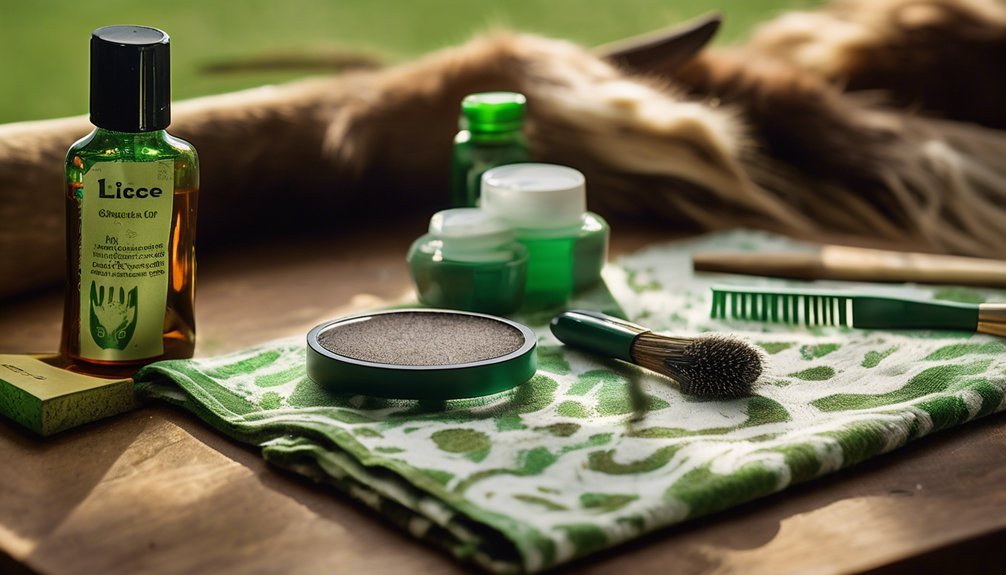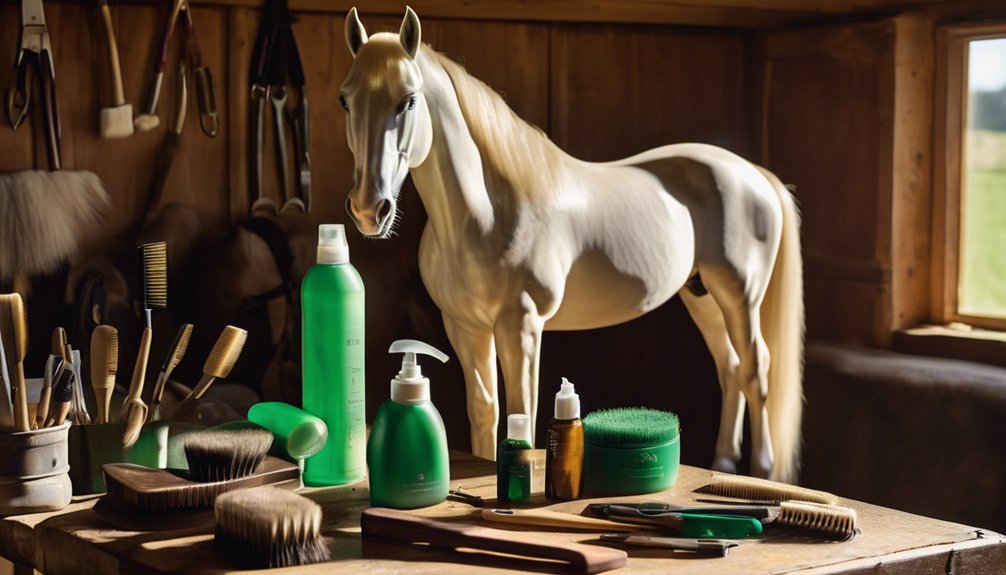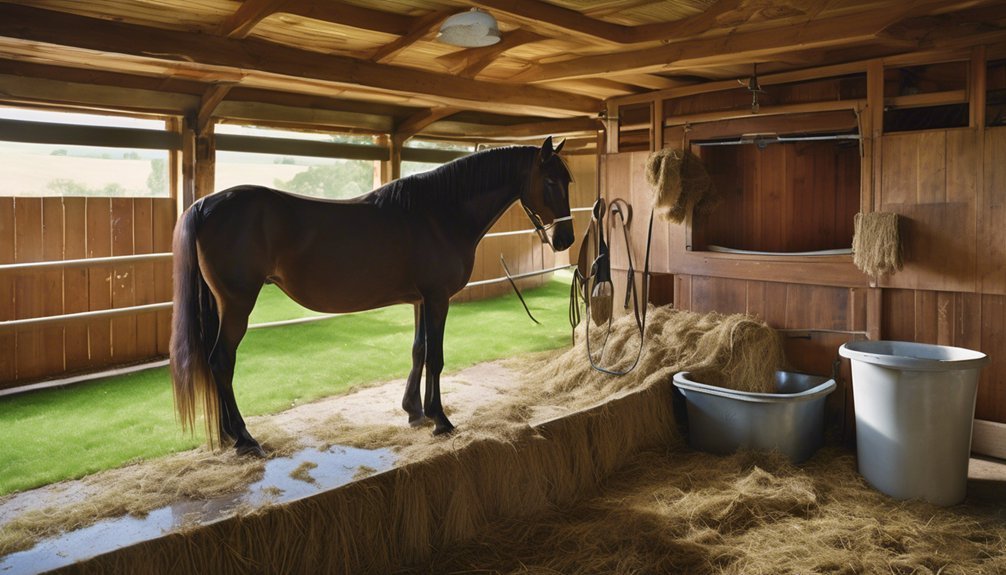
When it comes to preventing and treating horse lice, understanding the pest's life cycle is essential. You need to recognize the signs of infestation early to take action. Implementing effective preventive measures can save you time and effort later. Additionally, knowing the right treatment options is crucial for your horse's health. So, what steps can you take to ensure your horse remains lice-free? Let's explore the strategies you can employ.
Key Takeaways
- Regularly groom horses with effective brushing to remove lice and their eggs, promoting early detection of infestations.
- Use natural remedies like essential oils and diatomaceous earth as preventive measures against lice.
- Maintain a clean environment by regularly cleaning stalls and washing bedding to reduce lice breeding grounds.
- Consider topical treatments such as insecticidal shampoos and sprays after consulting with a veterinarian for safety.
- Avoid sharing grooming tools and equipment between horses to minimize the risk of lice transmission.
Understanding Horse Lice: Types and Life Cycle

Understanding horse lice is crucial for effective prevention and treatment.
Horse lice primarily fall into two infestation types: biting lice and sucking lice. Biting lice feed on dead skin and debris, while sucking lice attach to the skin and draw blood, causing discomfort and potential health issues.
The life cycle of horse lice includes three stages: egg, nymph, and adult. Eggs, or nits, attach to the horse's hair and hatch within a week. Nymphs mature into adults within two to three weeks, rapidly increasing the infestation.
Recognizing these types and understanding their life cycle can help you implement effective control measures, ensuring your horse remains healthy and comfortable.
Regular grooming and monitoring are essential to manage these pests effectively.
Signs of Lice Infestation in Horses
Detecting lice infestation in horses is vital for prompt intervention and treatment. One of the first signs you might notice is your horse's increased itch symptoms.
Watch for excessive scratching, biting at their skin, or rubbing against objects, which can indicate discomfort caused by lice behavior. You may also observe hair loss or thin patches, particularly along the mane, tail, and belly.
Additionally, check for tiny white or yellow eggs (nits) attached to the hair shafts; these are signs of an active infestation.
Keep an eye out for changes in your horse's demeanor, as irritability can also accompany lice infestations.
Being vigilant and recognizing these signs early will help you take action before the situation escalates.
Preventive Measures to Keep Your Horse Lice-Free

Once you've identified the signs of lice infestation, taking proactive steps to prevent these pests is important for your horse's health and comfort.
Begin by implementing effective grooming techniques; regular brushing helps remove debris and reduces lice populations. You can also use natural remedies, such as essential oils, which serve as deterrents when applied correctly.
Always maintain a clean environment by regularly washing bedding and disinfecting grooming tools. Additionally, avoid sharing equipment with other horses to minimize transmission risk.
Monitor your horse's health and behavior closely, as early detection is key. By establishing these preventive measures, you'll cultivate a healthier, lice-free environment for your horse, ensuring their overall well-being and happiness.
Effective Treatment Options for Horse Lice
When dealing with horse lice, it's crucial to implement effective treatment options promptly to alleviate your horse's discomfort. You can choose from various methods, including natural remedies and topical treatments. Natural remedies like essential oils (e.g., tea tree oil) can help repel lice, while topical treatments often contain insecticides specifically designed for equines.
| Treatment Type | Description |
|---|---|
| Natural Remedies | Essential oils, diatomaceous earth |
| Topical Treatments | Insecticidal shampoos, sprays |
| Combination Approach | Using both natural and topical options |
Exploring these options will help ensure your horse stays comfortable and lice-free. Always consult your veterinarian before starting any treatment to ensure safety and effectiveness for your unique situation.
Maintaining a Clean Environment for Your Horse

Effective treatment options can only do so much if the environment your horse lives in isn't kept clean. To maintain optimal stable hygiene, regularly clean stalls and remove manure and waste. This reduces the likelihood of lice infestations and promotes your horse's overall health.
Bedding maintenance is crucial; choose absorbent materials and replace them frequently to minimize moisture and bacteria buildup. Consider using straw or shavings that are easy to manage and dispose of.
Additionally, ensure proper ventilation in the stable to prevent dampness, which can attract pests.
When to Consult a Veterinarian for Lice Issues
How can you tell if your horse's lice problem requires professional intervention?
It's crucial to recognize the signs of severity to ensure your horse's well-being. Consider consulting your veterinarian if you notice:
- Persistent scratching or rubbing that doesn't improve with treatment.
- Skin irritation, inflammation, or open sores that develop.
- Significant hair loss or patchy bald spots.
- Changes in behavior, such as increased agitation or lethargy.
If your horse exhibits any of these symptoms, don't hesitate to seek professional help.
Early intervention can prevent further complications and promote a quicker recovery.
Trust your instincts—your horse relies on you to recognize when to consult a veterinarian for lice issues.
Frequently Asked Questions
Can Horse Lice Affect Other Farm Animals?
Yes, horse lice can potentially affect other farm animals. Horse lice transmission isn't typically direct, but susceptible animals might become infested if they share environments. Monitoring your livestock helps prevent cross-infestation and maintains overall health.
How Long Do Horse Lice Live Without a Host?
Imagine a ticking clock; horse lice have a brief lice lifespan of about 2 to 3 days without a host. They're highly dependent on their host for survival, making prompt action essential for control.
Are Horse Lice Contagious to Humans?
Horse lice transmission doesn't directly affect human health; they're specific to horses. While you won't catch them, maintaining hygiene around your horse is essential to prevent any potential irritation and keep both you and your horse comfortable.
Can I Use Home Remedies for Horse Lice?
You can use home remedies for horse lice, but ensure they're safe and effective. Natural treatments like neem oil or diatomaceous earth often serve as effective remedies, helping to manage infestations without harsh chemicals.
What Is the Cost of Professional Lice Treatment?
Professional lice treatment costs typically range from $50 to $200, depending on the services you choose and your horse's needs. Investing in expert help ensures effective treatment and protects your horse's health and comfort.
Conclusion
In conclusion, keeping your horse lice-free is essential for their comfort and health. By implementing preventive measures and effective treatments, you can ensure your equine companion remains happy and thriving. Remember, a little diligence in grooming and maintaining a clean environment goes a long way. Should you encounter persistent issues, don't hesitate to reach out to your veterinarian for expert guidance. Your horse deserves the best care, so let's keep those pesky intruders at bay!





